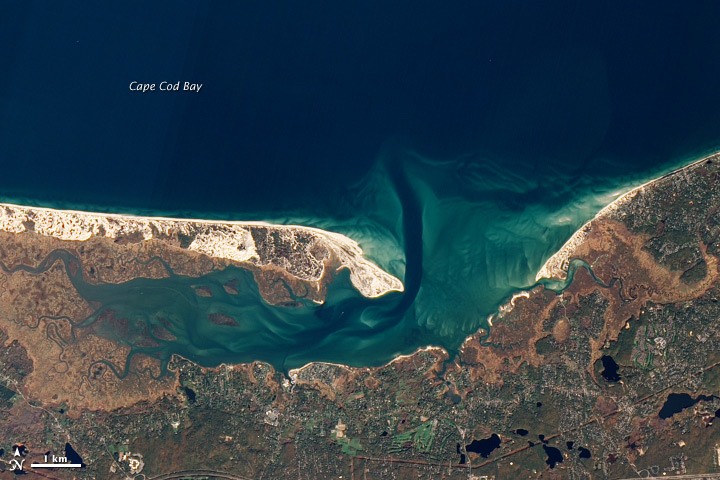

The oceans cover 70 percent of Earth. Because those waters are too vast for anyone to explore completely and too opaque to see through with cameras, we still have a lot to learn about them. One thing we do know is that the ocean is teeming with floating, drifting life, mostly microscopic.

Satellites allow scientists to observe the intersection of land, sea, and air, as at Sandy Neck on Cape Cod, Mass. But they cannot see more than a few meters into the ocean. (NASA Earth Observatory image by Robert Simmon, based on ALI data from Earth-Observing-1.)
Phytoplankton—tiny, plant-like cells that turn sunlight into food—are responsible for nearly half of the planet’s primary production. That is, they transform carbon dioxide, sunlight, and nutrients into organic matter. They are the base of the ocean food chain, the primary nourishment that fuels everything in the sea. The amount and location of phytoplankton affects the abundance and diversity of everything from finfish to shellfish and zooplankton to whales.
Phytoplankton also affect the chemistry and climate of the planet. Hundreds of millions of years ago, phytoplankton helped transform our atmosphere and pump it full of oxygen, paving the way for higher life forms. They still produce about half of the oxygen on Earth.

Algae such as Alexandrium tamarense (left) harness sunlight to make food for themselves, then become food for everything from krill, fish, turtles, and whales. (Photographs © WHOI, WHOI, Wiborg, deeje, and *christopher*.)
They also take carbon out of the atmosphere, locking it up for a time in their cells, in the animals that consume them, and in pellets of waste that drop to the sea floor and out of the atmosphere.
“We live in an era when many of the Earth’s ecosystems are under increasing strain from human exploitation and disruption of natural cycles,” says Mannino. “It is essential that we understand how critical components of the biosphere will respond to changes, and how those responses will feed back into carbon uptake and climate regulation.”
For all the importance of phytoplankton, scientists can only estimate and model the abundance and productivity of these tiny planet-changers. Large-scale observations are limited, so it is hard to say if phytoplankton populations are changing over time and what that means for other ecosystems.
“Phytoplankton feed the fishery,” says Margaret Mulholland, an oceanographer at Old Dominion University who is collaborating with Mannino on a four-year research project. “We need to measure their productivity across seasons and over time to determine how this productivity changes in response to short and long term climate changes.”